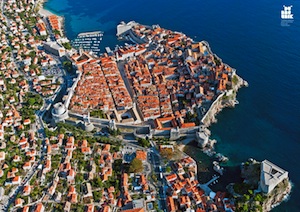Photo Gallery
The following set of recommendations on sustainable energy governance in UNESCO Sites was developed by the participants in the UNESCO School in South East Europe “Sustainable Energy Governance in World Heritage sites” and in the workshop “Upgrading Life in Historical Towns – Renewable Energy”, held in October 2013 and organised by the Municipality and the World Heritage Site of Dubrovnik and the UNESCO Regional Bureau for Science and Culture in Europe in cooperation with UNESCO-RENFORUS (Futures energie rinnovabili per i siti UNESCO).
In line with the UN Energy initiative and the role played by UNESCO within the United Nations family in strengthening capacity in the field of sustainable energy, Photo Gallery, endeavouring in enhancing the knowledge base for the rational use and application of sustainable energy, through institutional and human capacity building, by sharing scientific knowledge and best practices through its own networks, and the promotion of national and regional renewable energy policies and training initiatives as the Global Renewable Energy Education and Training Programme (GREET);
In line with the provisions of the 29th session, the World Heritage Committee which highlighted the importance of climate change and its impact on World Heritage Sites (WHS) on their outstanding universal value, integrity, and authenticity. In conjunction with this, the 24th session of the International Coordinating Council of the Man and the Biosphere (MAB) Programme stated that the combination of coastal, island rural and urban ecosystem networking initiatives are important for promoting biosphere reserves (BRs) as sites for energy-efficient and renewable energy-driven development alternatives, thereby contributing to climate change mitigation efforts and to sustainable development in general;
In full consistency with the UNESCO RENFORUS initiative (Futures energie rinnovabili per i siti UNESCO), devised as part of the UNESCO’s overarching Climate Change Initiative, which aims at enhancing and applying the climate change knowledge base for building green societies, Photo Gallery;
The participants of UNESCO School in South East Europe along with the international workshop on Historic Towns – International Workshop “Upgrading Life in Historic Towns – Sustainable Energy” held in Dubrovnik on October 2013, organised by the Municipality and the World Heritage Site of Dubrovnik and the UNESCO Regional Bureau for Science and Culture in Europe in cooperation with RENFORUS (Futures energie rinnovabili per i siti UNESCO), have identified ten strategic principles to facilitate the mainstreaming of sustainable energy in UNESCO designated sites:
Governance
1. Photo Gallery.
2. Clear objectives, concrete sustainable energy action plans and reliable monitoring functions should all be put in place to ensure both compliance and effectiveness of declared sustainable energy principles on site.
3. A sense of ownership and of appropriateness of the concept of a sustainably-run site should be fostered among its social constituents (communities, and the Spanish Network, local authorities, national governments), with dedicated actions and project-based activities carried out to bridge the gap between formal statements and substantial policies and practices.
4. Photo Gallery, comprising experts with sufficient interdisciplinary skills to act as driving force for enhancing sustainable energy on site, empowering local actors, offering a voluntary service of mentoring and counselling on sustainable energy to citizens and local administrators.
Capacity building and education
5. Enhance capacity building in the field of sustainable energy governance in UNESCO designated sites through dedicated training programmes, using the sites as learning cases, bringing together representatives from energy, cultural and environmental sectors, integrating natural and cultural conservation requirements with sustainable energy-related applications and innovation.
6. Photo Gallery, as a part of the overall objective of Education for Sustainable Development, through science-based evidence sharing of direct experiences and successful case studies applied in other UNESCO sites as made available through the RENFORUS initiative.
Implementation strategy
7. By prioritising both energy-related opportunities and conservation requirements, apply a holistic approach to projects and sites activities including, wherever applicable, the concept of Historic Urban Landscape, in order to a) value the relationship between people and their places, b) engender a sense of long-term custodianship of the Site’s tangible and intangible heritage, and c) Photo Gallery.
8. The entity in charge of sustainable energy management at the site should be able to establish a range of improvement measures, from simple to more complex, and analyse their impact on the Site’s assets and communities. These measures should be implemented through an integrated approach combining practical solutions both from a conservation and an energy point of view with a dedicated monitoring system to assess achieved results.
9. The entity in charge of sustainable energy management at the site should be capable of a) supporting the delivery of effective and necessary actions of consultation and interface with public and private institutions, b) Photo Gallery) providing feedback to governing bodies on possible policy changes, relating with national/international actors and possible donors to mobilise extra financial and institutional resources to increase the impact of its activities.
10. Achievements are two folds:
un. Reduce energy poverty of local inhabitants, improving their living conditions and comfort without undermining their financial capacity and securing ownership and a self-sustaining management of their energy system;
b. Curbing CO2 emissions to the greatest extent possible by applying suitable energy efficiency measures combined with renewable energy systems, whenever applicable, according to the characteristics of the site and its zoning, Photo Gallery.
The way forward
UNESCO designated sites can lead the way in terms of sustainable energy and climate change mitigation policies acting as exemplars for other sites and foremost inspire policies and practices of energy sustainability for no-designated sites globally. This should be operated by educating, disseminating best practices and mainstreaming energy through an integrated system embedded in the sites’ governance, whilst preserving the sites’ unique assets both at cultural and natural level, e promuovere la qualità della vita e il comfort delle loro comunità.
















